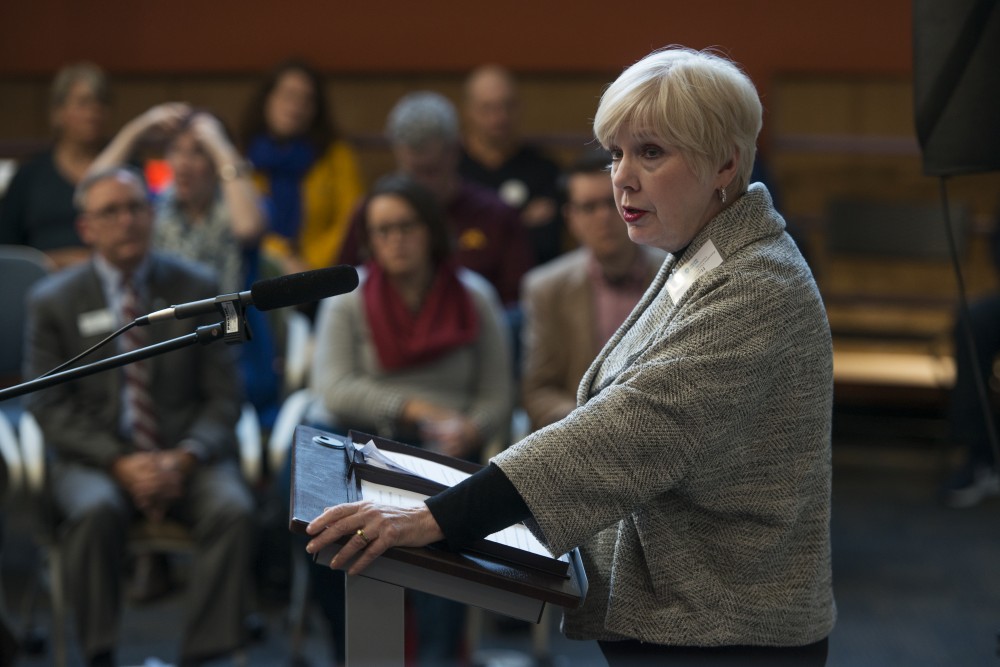The second of four candidates to be the next University of Minnesota provost was released Tuesday, the result of a monthslong search process to find the next chief academic officer for the system.
The process, spearheaded by a committee of faculty, staff and students, winnowed a field of roughly 60 candidates down to the four currently making their cases as to why they should be the next executive vice president and provost.
With the assistance of the search firm Korn Ferry, the committee helped outline what they were looking for in an ideal candidate by crafting a position profile, evaluating candidates and then interviewing 12 of them. Following those interviews, they landed on four finalists. Whomever President Joan Gabel taps to fill the second-highest position in the system will take on a wide range of responsibilities, such as directing strategic initiatives to advance the academic, research and outreach missions across the system.
“The top four that we have invited to come in, there really wasn’t much disagreement,” said Amy Pittenger, co-chair of the provost search committee.
Pittenger also served on the Presidential Search Advisory Committee that eventually landed Gabel as the sole public finalist last December and currently serves as chair of the Faculty Consultative Committee.
“Being the FCC chair comes with unexpected responsibilities,” Pittenger said. “A provost search is a really important hire for faculty.”
The committee balanced the value of including as many voices from across the University system at various levels as possible, while keeping in mind that there are drawbacks as a committee gets larger.
“We wanted a representative group, while trying not to make the committee too big,” Pittenger said.
James Farnsworth, an undergraduate student on the committee and communications director for the Minnesota Student Association, said the committee went through implicit bias training designed for search committees. Gabel cited this type of training as a way to ensure the University can “overcome anything we inadvertently do” in an interview with the Minnesota Daily last month.
“It was really important that we talked about what people’s individual biases are, how those can actually play out during search committee deliberations and then how to have really intentional conversations that avoid personal bias,” Farnsworth said.
Farnsworth said he focused on how often candidates brought up students in interviews but also considered other members of the University community, aiming to evaluate candidates from multiple perspectives.
Last spring, the University held a series of listening sessions around the system inviting various stakeholders to weigh in on what they wanted to see in the next provost. Pittenger said they used the responses from these sessions to craft the position profile which was used when advertising the position.
The search firm helped the committee recruit a diverse pool of candidates and served as an intermediary between applicants and the committee.
The committee then gathered to shrink the field of about 60 candidates down to 12 who would come to the University for confidential interviews, a tall order Pittenger said was a “happy problem to have.”
In these interviews, each candidate was asked the same series of questions in the same order in an attempt to keep the playing field as level as possible.
“If anybody had any pressing follow-up questions … everyone was welcome to just go, ‘could you clarify on that?’” said Andrew Durkot, a professional student on the committee and vice president of Professional Student Government.
Durkot said he was primarily looking for a candidate that would keep professional students in mind, citing distinct differences between professional students and other types of students at the University.
Upon completion of the interviews, committee members anonymously submitted their preferred candidates to the search firm. At the committee’s last meeting, they decided which of the candidates would be finalists.
Pittenger said there was a “remarkable” amount of agreement among committee members about who should be the four finalists.
Gabel was largely removed from the process, though it will ultimately be her decision who will be hired as the next provost.
“She was very explicit in that she was going to be hands-off,” Durkot said. “President Gabel said, ‘Don’t worry about me, worry about the University and pick someone that is best for the University.’”







